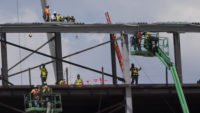NYC Metro's Megaprojects Lift Prospects for Subcontractors








From the $4.6-billion Manhattan West complex to the $3.9-billion Tappan Zee Bridge replacement span, the 2013 start-up of megaprojects in and around New York City has brightened prospects for specialty contractors with work forces large enough to handle the loads, say industry executives. The trend is more than a welcome sign to a sector hammered during a recession that drove some firms out of business and forced others to implement major cost-cutting initiatives.
"The economy in New York right now is smoking—very hot—and people are anticipating that will continue," says Gary Segal, president and CEO of GreenStar Services Corp., ranked No. 1 on this year's specialty contractor list. The firm's work includes electrical contracting through its Five Star Electric unit for the World Trade Center site, with such projects there as the September 11 Tribute in Light memorial.
Other massive projects include ongoing work at both the Metropolitan Transportation Authority's Second Avenue Subway and East Side Access projects; major bridge upgrades that include the $743.3-million effort to raise the deck of the Bayonne Bridge between Staten Island, N.Y., and Bayonne, N.J.; and the $400-million restoration to adapt the Brooklyn Navy Yard's 20-acre former hospital campus into a Hollywood-style film studio and media and technology hub.
The biggest industry gains, however, still remain concentrated in the city's core. Executives point out that subcontracting work in most of the rest of the tristate region is only on a gradual upswing. The big exception, they add, is in areas where Superstorm Sandy hit the hardest. In these locations, the electrical trades remain in great demand. The Sandy work includes repairs as well as the start of several long-term resiliency projects.
"While the World Trade Center is still in development, underground it had to be partially rebuilt after Sandy [due to flooding]," says Anthony Guzzi, president and chief executive officer of EMCOR Group (ranked No. 2), which is another major WTC subcontractor. "It's still a big project."
EMCOR's Welsbach Electric subsidiary recently won a contract to install the electrical systems on the Tappan Zee project. The new bridge, which will span the Hudson River between New York's Rockland and Westchester counties, will consist of two separate bridge structures, each about three miles long.
"It's going to be a different project because, obviously, it's across the Hudson River and it's a long span, but we're going to use some very creative prefabrication tools to build that to make it as safe and productive as we can," Guzzi says. He did not elaborate further.
Welsbach, whose contract covers power, intelligent transportation, security and communications systems, will install more than 500 million ft of conduit and 3 million ft of wire and cable. Its scope of work includes installation of roadway and aesthetic lighting, temporary electronic tolling, structural health monitoring and life safety systems.
On the buildings side, Manhattan's residential market is also spurring demand for MEP engineers and other trades, especially high-rise developments. While the city's office sector still lags other markets, massive mixed-use projects in Manhattan include the 26-acre, $15-billion Hudson Yards and the nearby 5.4-million-sq-ft Manhattan West developments.
"There's not a lot of out-of-the-ground skyscrapers that are not residential … but there's a lot of activity," Guzzi says. He adds that in the office sector, renovation and "restacking" of real estate is up.
Growth is spotty in Connecticut—like the rest of New England apart from the Boston metropolitan area—but the New Haven-to-Stamford corridor is an exception. Construction activity is on the upswing there due to its proximity to New York City, says Eric Green, vice president at Erland Construction, East Windsor, Conn. "We're seeing a lot of multifamily housing, lots of 200-plus apartment buildings going up," he says.
Erland is construction manager on one of those projects—the 22-story, $62-million Summer House residential mixed-use structure in Stamford. The 334,000-sq-ft project, which is being built over a restaurant while it remains in operation, will contain about 2,436 tons of structural steel and trusses. This includes a 52-ft steel girder for the span.
Ocean Steel Corp., Conklin, N.Y., began steel and precast plank erection in July and expects completion next February. The entire project is targeted for completion by the end of 2015.
In northern New Jersey, "there's a handful of major projects, and everyone's waiting to see what will happen with them," says Kevin Monaco, executive director of the New Jersey Subcontractors Association. These include several high-rise residential projects in and near Jersey City, he says.










